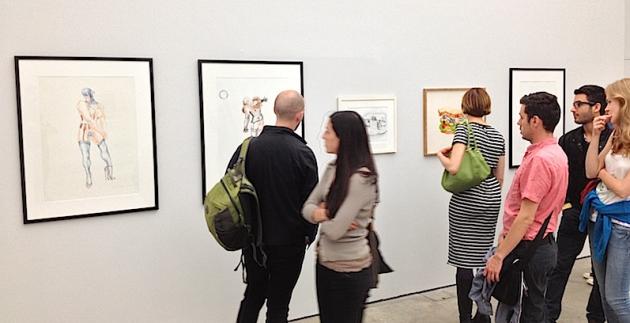In a talk given in Berlin in 2012 entitled Is the Old New? or is the New Old? the British feminist artist Margaret Harrison began with the words: ‘I’m probably the oldest emerging artist you’ll ever meet. We seem to be a little bit in fashion recently.’ Ms Harrison was speaking about the crop of women artists now in their 70s, 80s, even in their 90s, whose work is finally receiving the acclaim it has long deserved.
Margaret Harrison’s career as an artist began in the late 1960s. Hers was the first overtly feminist one-woman art show in London. It was closed down by police after one day on grounds of indecency. Her work uses humour and exquisite draughtsmanship to examine cultural and societal attitudes towards sexuality and the constructed nature of gender, as well as documenting historic exploitation and abuse of women. “All that pioneering work which was largely ignored until recently has been re-assessed, mainly through the public spaces and through major women’s shows in the US and Europe,” Ms Harrison says.
After a dry spell of four decades she has now begun enjoying solo shows again. Her work is currently at the Institute of Contemporary Art alongside the likes of Georg Grosz in a show of radical works on paper entitled Keep Your Timber Limber. At the same time she has a solo show at PayneShurvell, London. In 2015 Middlesborough Institute of Contemporary Art (MIMA) will present a solo show and last month she clinched the prestigious Northern Art Prize, beating strong contenders Emily Speed, Rosalind Nashashibi and Joanne Tatham & Tom O’Sullivan.
But the danger is that this re-evaluation ends up not being a re-evaluation at all when the work’s new found success is put down to factors of gender and now age, as opposed to quality and significance. The Northern Art prize this year received far wider press coverage than it has in the past for all the wrong reasons. The BBC reported the outcome: “An artist in her 70s has won a £16,500 art prize for a recreation of the perimeter fence from the Greenham Common airbase.” It went on to say “Margaret Harrison, 72, who lives in Carlisle, has been named winner of the Northern Art Prize in Leeds.” And then, in case any doubt remained as to which the significant fact was: “she was the oldest nominee in the prize’s seven-year history.” From sexism to ageism. “It’s demeaning,” Ms Harrison remarks.
Rose Wylie agrees. Ms Wylie makes paintings using bold, naïve motif as a means of commenting on contemporary culture. The bulk of her career has been spent in anonymity. Now her work is showing at Tate Britain. In 2010 she was written about in The Guardian by Germaine Greer under the headline “Who is Britain’s hottest new artist? A 76-year-old called Rose Wylie”. Whilst acknowledging that it is certainly true that there is a wave of women artists now enjoying a flush of success that has been denied to them previously, and that this is undoubtedly a good thing both for the artists concerned and for the art world as a whole, she finds it frustrating to be categorised as such. “It’s just another way of dismissing the work,” she says. “I don’t feel that age. It doesn’t matter. The label becomes very irritating. One wants the work looked at. It’s inappropriate to reduce it to these two elements.”
Judith Bernstein seems less concerned with categorisation. She’s an artist from New York who produces phallic heavy feminist work on a huge scale that deals with issues of war, sexual and political violence, power, posturing, fame and the ego. Interestingly, Ms Bernstein also had her work censored from a show in the 70s on the grounds that it was ‘without redeeming social value’, an extraordinary claim in retrospect. Between 1987 and 2008 Ms Bernstein sat out a twenty-four year spell without a solo exhibition, her work divorced from it’s larger context by marginalisation into niche and feminist shows, until she was recently re-discovered. “I’m back while I’m still alive!” she says triumphantly. “Things have changed quite a bit, not completely but quite a bit. Women have not gotten their due. We just want access to the system.”
It seems that the issue of access to the system is a complex one and that what purports to be equality of opportunity is often inequality in another guise. As Margaret Harrison says, “there is a constant desire to find out what is new, but the new is often the old.”

Margaret Harrison and Judith Bernstein are showing in Keep Your Timber Limber at the ICA until 8 September
Rose Wylie is showing at Tate Britain until 6 October
Words: Beverley Knowles © Artlyst 2013 Top Image: Margaret Harrison ICA Bottom Image: Rose Wylie

